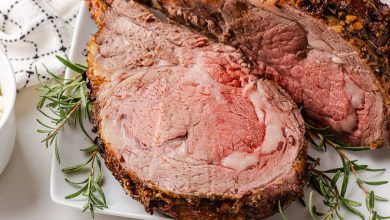Pork Fresh Leg (Ham) Rump Half, Raw – Nutritional Information and Health Benefits
Pork fresh leg, also known as ham rump half, is a tender and flavorful cut of pork that offers a rich, juicy taste and is versatile in many dishes, from roasts to stews. It’s often enjoyed for its balance of lean protein and savory fat content, making it a delicious option for various meals.
Nutritional Profile:
| Nutrient | Amount per 100g |
|---|---|
| Energy | 182.0 kcal |
| Protein | 20.27 g |
| Fat | 10.63 g |
| Saturated Fat | 3.53 g |
| Carbohydrates | 0.0 g |
| Fiber | 0.0 g |
| Sugar | 0.0 g |
| Calcium | 12.0 mg |
| Iron | 0.62 mg |
| Magnesium | 20.0 mg |
| Phosphorus | 216.0 mg |
| Potassium | 356.0 mg |
| Sodium | 73.0 mg |
| Zinc | 1.7 mg |
| Copper | 0.079 mcg |
| Manganese | 0.009 mg |
| Selenium | 19.7 mcg |
| Vitamin C | 0.0 mg |
| Thiamin (Vitamin B1) | 0.498 mg |
| Riboflavin (Vitamin B2) | 0.309 mg |
| Niacin (Vitamin B3) | 5.623 mg |
| Vitamin B6 | 0.506 mg |
| Folate | 0.0 mcg |
| Vitamin B12 | 0.4 mcg |
| Vitamin A | 5.0 mcg |
| Vitamin E | 0.2 mg |
| Vitamin D2 | 0.5 mcg |
Key Nutrients and Health Benefits:
- Protein: At 20.27 grams of protein per 100 grams, pork fresh leg is a rich source of high-quality protein, essential for muscle growth, tissue repair, and immune function.
- Fat: Contains 10.63 grams of total fat, with 3.53 grams of saturated fat. While this contributes to its rich flavor, it’s important to consume in moderation, particularly if managing dietary fat intake.
- Vitamins & Minerals: This cut of pork is a great source of several essential vitamins and minerals, including:
- Vitamin B6 (0.506 mg), important for brain health and metabolism.
- Niacin (Vitamin B3), which plays a crucial role in converting food to energy.
- Phosphorus (216 mg) and Potassium (356 mg), which support healthy bones and muscle function.
- Iron (0.62 mg) for red blood cell production and oxygen transport.
- Selenium (19.7 mcg), an antioxidant that helps protect cells from damage.
Dietary Considerations:
- Allergen Information: Pork is naturally free from common allergens such as gluten, dairy, nuts, and soy. However, those with specific dietary restrictions or allergies should ensure that the pork is sourced from trusted suppliers to avoid cross-contamination with allergens.
- Dietary Preferences: Pork fresh leg is suitable for those following low-carb, high-protein diets, such as ketogenic or paleo diets. It is not appropriate for individuals following vegetarian or vegan diets.
Culinary Uses:
Pork fresh leg, or ham rump half, is a versatile ingredient in the kitchen. It can be roasted, slow-cooked, grilled, or sliced for sandwiches. It’s perfect for family meals, holiday dinners, or any occasion requiring a hearty, savory dish.
Conclusion:
Pork fresh leg (ham) rump half is a flavorful and nutrient-dense option that offers a high-protein, low-carbohydrate meal base with beneficial vitamins and minerals. Whether roasted, braised, or slow-cooked, it can be a centerpiece for many traditional and modern dishes. Always consider balance in your diet to enjoy its benefits while maintaining overall health.










